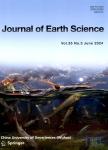Reworking of the Juvenile Crust in the Late Mesozoic in North Qinling,Central China
Reworking of the Juvenile Crust in the Late Mesozoic in North Qinling,Central China作者机构:Center of Deep Sea ResearchInstitute of OceanologyChinese Academy of SciencesQingdao 266071China Laboratory for Marine Mineral ResourcesPilot National Laboratory for Marine Science and Technology(Qingdao)Qingdao 266237China School of Earth and Space SciencesUniversity of Science and Technology of ChinaHefei 230026China Center for Ocean Mega-ScienceChinese Academy of SciencesQingdao 266071China University of Chinese Academy of SciencesBeijing 100049China
出 版 物:《Journal of Earth Science》 (地球科学学刊(英文版))
年 卷 期:2022年第33卷第3期
页 面:623-641页
核心收录:
学科分类:070904[理学-构造地质学] 070903[理学-古生物学与地层学(含:古人类学)] 0709[理学-地质学] 07[理学] 0708[理学-地球物理学]
基 金:financially supported by the Ministry of Science and Technology of China (No.2016YFC0600404) the Strategic Priority Research Program of the Chinese Academy of Sciences (No.XDB42020303) the National Natural Science Foundation of China (Nos.41872049,41372072,and 41903006) the partly supported by the China Postdoctoral Science Foundation (Nos.2019M652497 and2020T130656)
主 题:Qinling Orogen Mesozoic granite crustal reworking Nd isotope geochemistry
摘 要:The Qinling Orogen resulted from the collision between the North and South China blocks in the Triassic.Mesozoic granitoids,ranging from the Triassic to the Cretaceous,are widely distributed in this orogen,and they provide excellent clues for understanding the crustal evolution and geodynamic evolution of the orogenic belt.The Triassic belt is mostly located in the South Qinling,whereas the Cretaceous belt is located mostly in the North Qinling.The Taibai complex pluton is located at the conjunction of the two belts.Here we present a data set comprising zircon U-Pb dating and elemental and Sr-Nd isotopic geochemistry for Late Mesozoic granite and microgranular enclaves(MME)exposed in the Taibai complex pluton.The granite and MME yield concordant U-Pb zircon ages of 124 to 118 Ma,indicating that they were products of roughly simultaneous magmatism in the Late Mesozoic.The granite rocks are high-K,calc-alkaline,and weakly peraluminous in compositions,and they are characterized by enrichment in large ion lithophile elements(e.g.,Rb,Ba),depletion in high field strength elements(e.g.,Nb,Ta,Zr,Ti),and variable Sr/Y ratios of 7.64 to 63.6.Low MgO,Cr,and Ni contents imply that the magma(s)were essentially crust-derived.Both the granite and the MME show relative depletion in Sr-Nd isotopic composition(initial ^(87)Sr/^(86)Sr of 0.7044 to 0.7067,initialε_(Nd) values of-3.4 to-2.6),suggesting that the magma(s)originated from juvenile crustal rocks.These Sr-Nd isotopic characteristics are significantly different from those of other Late Mesozoic granitoids exposed elsewhere in the Qinling orogenic belt,which formed from much older and enriched sources and with negligible contributions from mantle or juvenile crust.We propose a reworking event of the juvenile crust during the Late Mesozoic that was triggered by the tectonic extension and subsequent asthenospheric upwelling that occurred in eastern China.



